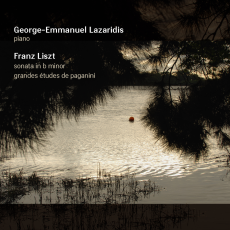Liszt - Lazaridis - Audiophile Audition
Recorded at The Maltings, Snape, UK, 15-28 May 2006, the Liszt Sonata finds another young acolyte in George-Emmanuel Lazaridis, a Greek artist with plenty of fingers and the Romantic temperament to carry off the rhetorical gestures without mannerism. The liner notes provide no indication of the instrument used, but it is bright and warm, expertly captured in its magnificent resonance by Philip Hobbs. In surround sound we hear every note, fluid or demonic, solo and in concert, with Liszt's immensely chromatic harmonies. The absolute fluency of Lazaridis' playing comes out in his left hand figurations, which themselves undergo transformation into melos of a high order. This kid packs some trill! Expansive, lyrical, eminently dramatic without permitting the line to sag or digress into discreet episodes, Lazaridis keeps the musical thought fixed within the mercurial parameters of its given shape of three themes.
At twenty minutes into Lazaridis' rendition, we have the massive recapitulation section, with the low G that ushers in the melody's contrapuntal incarnation, a bravura display of polyphonic control worth the entire price of admission. Wicked trill that energizes the ecstatic thrusts into Dante's visions of Heaven and Hell. Mephisto Waltz, Mephisto Polkas, and Totentanz blaze before our ears en passant. The D Major Grandioso theme returns, then a series of antiphons marcato and espessivo. Shimmering arpeggios throughout, articulate passing ornaments and flourishes; they make us wonder if Lazaridis, and not Arcady Volodos, is the natural successor to Horowitz' Liszt. Titanic hurling of Lisztian thunderbolts at the final peroration, just before the resigned, extended coda that resolves itself into its opening, metaphysical dew.
The 6 Paganini Etudes, from the outset, are not so much an anticlimax after the Sonata but a kind of addendum. The opening etude (G Minor) combines two Paganini caprices for arpeggios and scales, with constant motion emanating from the wrists. The thunderous chords exemplify Liszt's modal style that often borrows from Bach chorales. Lazaridis exaggerates the silences between the alternating episodes of scales and double octaves in Caprice 17 in E-flat, then he pushes them together (C Minor) most eloquently. Lazaridis adds a brisk cadenza, then back to E-flat. La Campanella, with its brilliant repeated notes and wild flourishes, is entirely Paganini, king of all he musically surveys. Playful, deftly leggierissimo, and elegantly fluid, the piece lights on dragonfly wings then surges up a lion's paw. The E Major makes a keyboard work of Paganini's Caprice No. 1, with its spiccato arpeggios, all within a single stave of music. Double-stops in harmonics in Paganini's Caprice No. 9 "La Chasse" have become pianistic imitations of fife and horn. Excellent distribution of terraced dynamics for the weighty middle section. Finally, the A Minor variations of Caprice No. 24, chiseled with fervor and panache. In a musical market glutted with the Liszt Sonata, this disc makes you concede that there is indeed room for one more.

